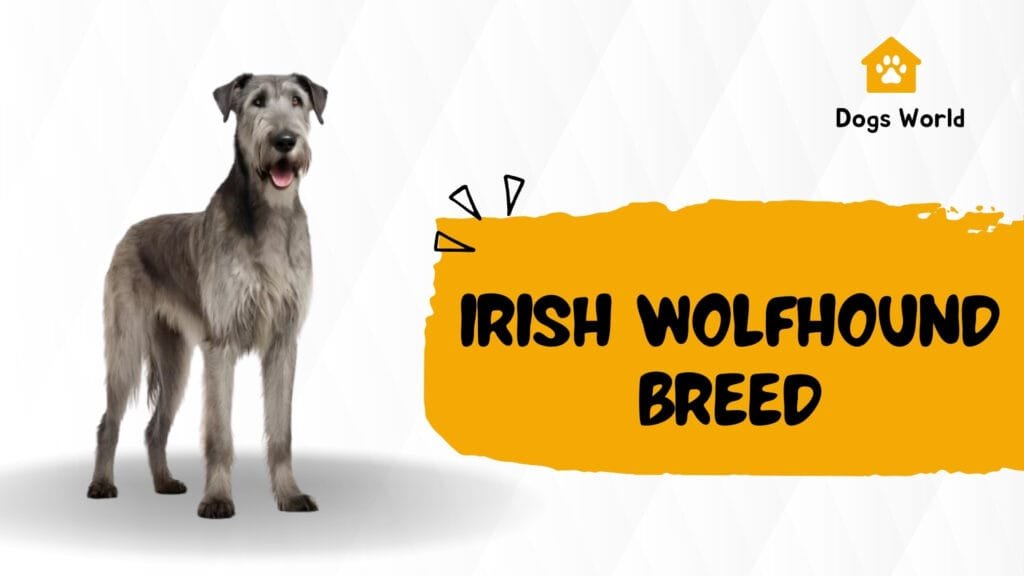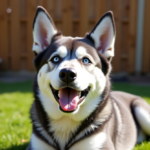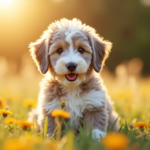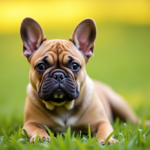The Irish Wolfhound is one of the largest and most majestic dog breeds in the world. Known as a “gentle giant,” this breed is famous for its tall stature, friendly personality, and rich history dating back to ancient Ireland. Despite their enormous size, Irish Wolfhounds are calm, loyal, and loving, making them great companions for families, seniors, and dog lovers alike. They were originally bred to hunt large game like wolves and deer, but today, they are cherished as affectionate pets. While owning an Irish Wolfhound is a joy, it also requires careful attention to their health, diet, exercise, and grooming.
These dogs need plenty of space to move around, regular exercise to stay healthy, and a proper diet to support their large size. Irish Wolfhounds are prone to health issues such as bloat, bone cancer, and hip dysplasia, so regular vet visits are crucial. Grooming is relatively simple but should include coat brushing, ear cleaning, and skin care. Training and socialization are essential for these intelligent dogs, and they enjoy activities like long walks and playtime in open spaces. If you’re considering bringing an Irish Wolfhound into your life, this guide will help you understand their unique needs and how to care for this noble breed.
Irish Wolfhound Overview
The Irish Wolfhound is recognized as the tallest dog breed, often referred to as a “gentle giant.” Despite its size, the Irish Wolfhound is calm, loyal, and highly affectionate. This breed is perfect for families who want a large yet gentle companion.
Key Characteristics of the Irish Wolfhound
| Feature | Details |
|---|---|
| Height | 30-35 inches (males), slightly shorter (females) |
| Weight | 105-120 pounds (females), 120-180 pounds (males) |
| Lifespan | 6-8 years |
| Coat | Rough, wiry, and medium-length |
| Temperament | Gentle, loyal, and calm |
| Exercise Needs | Moderate; at least 30-60 minutes daily |
Irish Wolfhounds are known for their easygoing temperament, making them well-suited for families with children or other pets. However, their size requires ample space to move and exercise.
Irish Wolfhound History
The Irish Wolfhound has a storied past that dates back to ancient times. First mentioned in Irish literature around 391 AD, the breed was initially used to hunt large game, including wolves and elk. These dogs were revered for their strength, speed, and loyalty.
Key Historical Points
- Origins: The breed’s ancestry is tied to Ireland, where it was a symbol of nobility and bravery.
- Role in Warfare: Irish Wolfhounds were used in battles to pull men off horseback.
- Decline and Revival: The breed’s numbers dwindled during the 18th century due to the extinction of wolves in Ireland. Captain George Augustus Graham is credited with reviving the breed in the 19th century.
- Modern Status: Today, the Irish Wolfhound is celebrated for its historical significance and gentle nature, often associated with Irish culture and heritage.
Characteristics of the Irish Wolfhound
Irish Wolfhounds have a unique combination of physical and behavioral traits that make them stand out.
Physical Traits
- Coat: Rough and wiry, requiring regular grooming
- Colors: Common colors include gray, brindle, black, white, and red
- Build: Tall and muscular, with a deep chest and long legs
Temperament
- Gentle: Known for their calm and patient demeanor
- Loyal: Extremely devoted to their families
- Intelligent: Quick learners but can be independent at times
Irish Wolfhounds are friendly with children and other pets, making them ideal for families who can accommodate their size and care needs.
Irish Wolfhound Personality
The Irish Wolfhound’s personality is a mix of loyalty, gentleness, and intelligence. This breed thrives on companionship and bonds deeply with its family.
Notable Traits
- Gentle Giant: Despite their imposing size, Irish Wolfhounds are calm and rarely show aggression.
- Affectionate: They are known to be incredibly loving and enjoy being close to their human companions.
- Intelligent: They can quickly learn commands, though they may show a streak of independence.
Their temperament makes them ideal for families, seniors, and even novice dog owners, provided they can accommodate the breed’s size and care requirements.
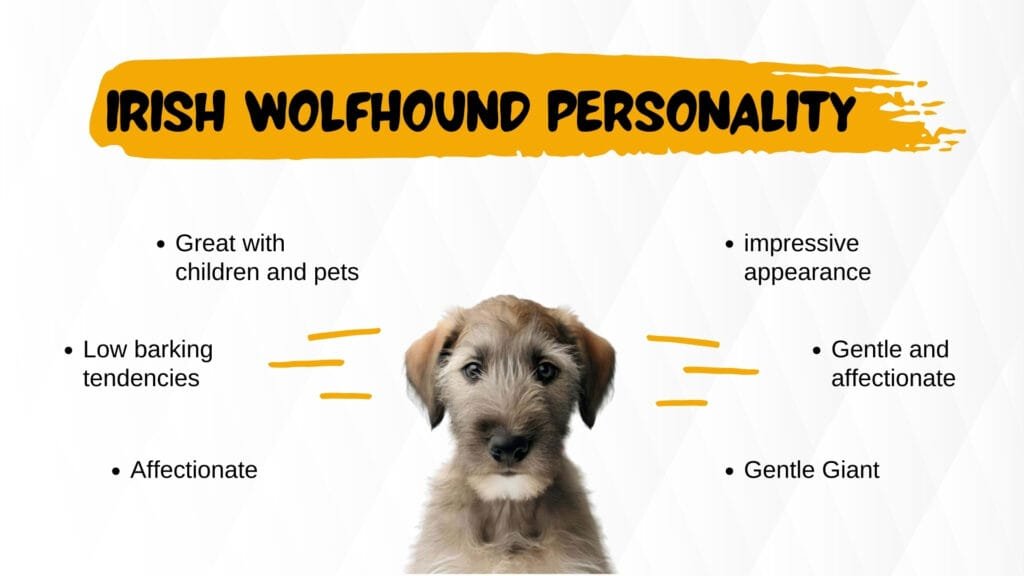
Caring for an Irish Wolfhound
Caring for an Irish Wolfhound involves meeting their needs for space, exercise, grooming, and healthcare. These dogs thrive in environments where they can move freely and be part of family activities.
Key Care Tips
- Space: Irish Wolfhounds need a large yard or access to open spaces for exercise.
- Exercise: At least 30-60 minutes of moderate exercise daily is essential.
- Socialization: Early exposure to different environments, people, and animals ensures a well-adjusted adult dog.
- Health Monitoring: Due to their size, regular vet checkups are crucial to catch health issues early.
Irish Wolfhound Health Issues
Like many giant breeds, the Irish Wolfhound is prone to certain health problems. Being aware of these conditions can help in early detection and management.
Gastric Dilatation-Volvulus (GDV) and Bloat
Bloat is a common and potentially fatal condition in large breeds. It occurs when the stomach twists, trapping gas and food. Symptoms include restlessness, a distended abdomen, and unproductive retching. Immediate veterinary care is essential.
Bone Cancer (Osteosarcoma)
Irish Wolfhounds are susceptible to osteosarcoma, an aggressive form of bone cancer. This condition often requires a combination of surgery and chemotherapy.
Hip Dysplasia
Hip dysplasia is a genetic disorder where the hip joint doesn’t fit properly, leading to arthritis and pain. Regular exercise and maintaining a healthy weight can help manage symptoms.
Elbow Dysplasia
Elbow dysplasia, like hip dysplasia, involves abnormal joint development. This condition can cause lameness and discomfort in affected dogs.
Dilated Cardiomyopathy (DCM)
DCM is a heart condition where the heart becomes enlarged and less effective at pumping blood. Regular cardiac screenings are recommended for early detection.
Common Health Problems in Irish Wolfhounds
| Health Issue | Description | Prevention/Treatment |
|---|---|---|
| Gastric Dilatation-Volvulus | Stomach twists, trapping gas and fluids; life-threatening emergency. | Feed smaller meals; avoid exercise post-meal. |
| Osteosarcoma | Aggressive bone cancer common in large breeds. | Early diagnosis and specialized treatment. |
| Hip Dysplasia | Malformed hip joint causing pain and mobility issues. | Breeding practices; supplements, surgery. |
| Elbow Dysplasia | Developmental joint condition leading to arthritis. | Proper diet and joint care. |
| Dilated Cardiomyopathy (DCM) | Weakening of the heart muscle, leading to decreased blood flow. | Regular cardiac exams. |
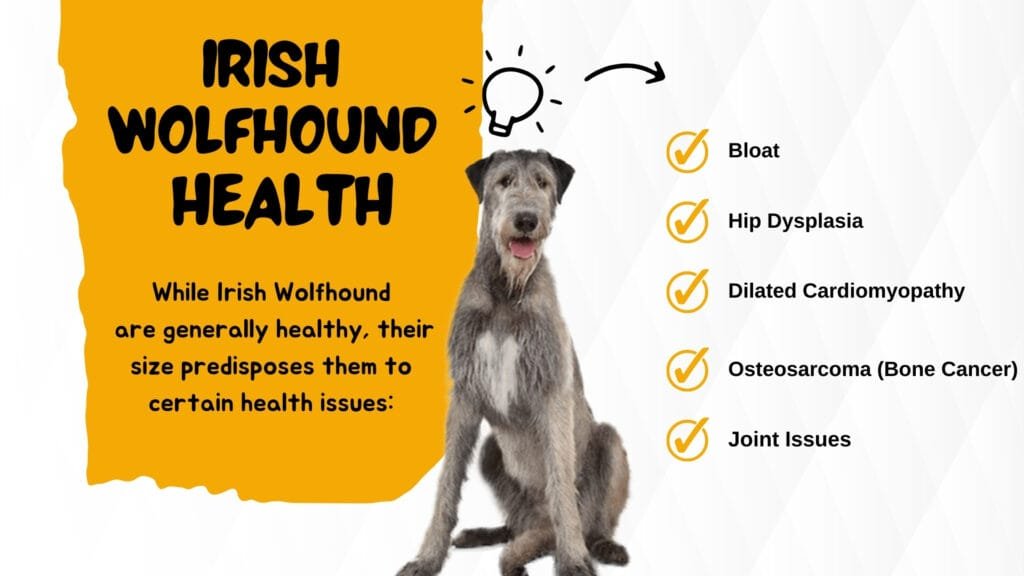
What to Feed an Irish Wolfhound
A balanced diet is crucial for the health and well-being of an Irish Wolfhound. Look for high-quality dog food specifically designed for large breeds.
Dietary Essentials
- Protein: Supports muscle growth and repair.
- Healthy Fats: Provide energy and promote coat health.
- Calcium and Phosphorus: Support bone development, especially in puppies.
- Glucosamine and Chondroitin: Help maintain joint health.
How to Feed an Irish Wolfhound
Divide meals into smaller portions throughout the day to reduce the risk of bloat. Always provide fresh water, and avoid feeding immediately before or after exercise.
How Much Should You Feed an Irish Wolfhound?
The amount of food depends on the dog’s age, size, and activity level. On average:
Feeding Guide for Irish Wolfhounds
| Age/Stage | Number of Meals/Day | Approximate Portion per Meal | Notes |
|---|---|---|---|
| Puppy (8-12 weeks) | 4 | 1-1.5 cups | Use a large-breed puppy formula. |
| Adolescent (3-12 months) | 3 | 2-3 cups | Avoid overfeeding to prevent rapid growth. |
| Adult (1+ years) | 2 | 3-4 cups | High-protein, low-grain diet recommended. |
| Senior (6+ years) | 2 | 2-3 cups | Adjust for activity level; monitor weight. |
Consult your vet for personalized recommendations based on your dog’s specific needs.
Nutritional Tips for Irish Wolfhounds
- Avoid feeding table scraps, as they can upset the digestive system.
- Use supplements like fish oil for a shiny coat and healthy joints.
- Transition foods gradually to prevent gastrointestinal upset.
Behavior and Training Tips for Irish Wolfhounds
Training and socializing an Irish Wolfhound are essential for ensuring a well-behaved companion.
Irish Wolfhound Personality and Temperament
These dogs are friendly, patient, and rarely aggressive. Proper socialization ensures they remain confident and calm in various situations.
Irish Wolfhound Behavior
Irish Wolfhounds are generally easygoing but may display a strong prey drive. Early training helps manage this instinct.
Irish Wolfhound Training
- Positive Reinforcement: Use treats and praise to reward good behavior.
- Consistency: Keep training sessions short but regular to maintain engagement.
- Leash Training: Essential due to the breed’s size and strength.
Fun Activities for Irish Wolfhound
- Long walks in the countryside.
- Playing fetch in a large yard.
- Participating in canine sports like lure coursing.
Irish Wolfhound Grooming Guide
Regular grooming keeps your Irish Wolfhound healthy and comfortable.
Skin Care
Check for signs of dryness, irritation, or hot spots. Use hypoallergenic shampoos for baths.
Coat Care
Brush weekly to remove loose hair and prevent tangles. Use a slicker brush or a comb designed for rough coats.
Eye Care
Clean the area around the eyes with a damp cloth to prevent discharge buildup.
Ear Care
Inspect and clean the ears weekly to prevent infections. Use a vet-approved ear cleaner and avoid inserting anything deep into the ear canal.
Grooming Checklist for Irish Wolfhounds
| Grooming Task | Frequency | Tools Needed |
|---|---|---|
| Brushing Coat | 2-3 times per week | Slicker brush or pin brush |
| Bathing | Once every 6-8 weeks | Dog-safe shampoo |
| Nail Trimming | Every 3-4 weeks | Nail clippers or grinder |
| Ear Cleaning | Weekly | Cotton balls, vet-recommended cleaner |
| Dental Care | Daily/Weekly | Dog toothbrush and toothpaste |
Where to Adopt or Buy an Irish Wolfhound
Finding the right Irish Wolfhound can be a rewarding experience if approached thoughtfully. Whether you choose to adopt or purchase, thorough research and preparation are essential to ensure a healthy and well-suited match for your family.
Adopting an Irish Wolfhound
Adopting an Irish Wolfhound from a rescue organization or shelter is a compassionate and often cost-effective choice. Many dogs in shelters are there through no fault of their own and are looking for loving homes.
Steps to Adoption
- Contact Breed-Specific Rescues: Organizations dedicated to Irish Wolfhounds often rescue, rehabilitate, and rehome these dogs. Examples include the Irish Wolfhound Rescue Foundation or similar local groups.
- Visit Local Animal Shelters: While less common, some shelters may have Irish Wolfhounds or Irish Wolfhound mixes available for adoption.
- Complete an Application: Rescues typically require an application to ensure the adopter is a good match for the breed’s needs.
- Prepare for a Home Visit: Some organizations may perform a home check to confirm you can accommodate a large dog.
Adopting an Irish Wolfhound can be less expensive than buying from a breeder, with adoption fees typically ranging from $200 to $500. These fees often include vaccinations, spaying/neutering, and basic veterinary care.
Buying an Irish Wolfhound
If you prefer a purebred Irish Wolfhound puppy, purchasing from a reputable breeder is a popular choice. However, this process requires diligence to avoid supporting unethical breeding practices.
How to Choose a Breeder
- Research Thoroughly: Look for breeders with a strong reputation and positive reviews. The Irish Wolfhound Club of America (IWCA) provides a directory of ethical breeders.
- Visit the Breeder’s Facility: Inspect the living conditions of the dogs. Puppies should be raised in a clean, safe, and social environment.
- Meet the Parents: Seeing the puppy’s parents can provide insight into the dog’s future size, temperament, and health.
- Ask for Health Clearances: Responsible breeders provide documentation showing their dogs have been tested for common breed-specific health issues, such as hip dysplasia and heart conditions.
- Review Contracts: Ethical breeders often include a spay/neuter clause and a return policy if you can no longer care for the dog.
Cost of Buying an Irish Wolfhound
The price of an Irish Wolfhound puppy ranges from $1,500 to $3,500, depending on the breeder, lineage, and location. Show-quality puppies or those with championship bloodlines may cost more.
Online Resources for Adoption and Breeders
- Petfinder: A comprehensive database of adoptable pets, including Irish Wolfhounds.
- Adopt-a-Pet: Connects potential adopters with shelters and rescues across the U.S.
- Irish Wolfhound Club of America (IWCA): Offers resources for finding reputable breeders and rescues.
- AKC Marketplace: Lists breeders registered with the American Kennel Club.
Things to Consider
Whether you adopt or buy, it’s crucial to evaluate your readiness for an Irish Wolfhound. This breed requires ample space, regular exercise, and a significant financial commitment for food, grooming, and veterinary care.
Pros and Cons of Irish Wolfhounds
| Pros | Cons |
|---|---|
| Gentle and affectionate | Short lifespan (6-8 years) |
| Great with children and pets | Susceptible to several health issues |
| Low barking tendencies | Expensive to maintain (food, vet bills) |
| Noble and impressive appearance | Require large living space |
Adopting or buying this dog should always be done through reputable channels to ensure the health and welfare of the dog. By making an informed choice, you’ll be well on your way to welcoming a loving and loyal dog into your home.
Conclusion
The Irish Wolfhound is a breed like no other. From its noble history to its gentle nature, this dog has captured the hearts of many. Owning this dog requires commitment, but the rewards far outweigh the effort. By providing proper care, nutrition, and love, you can enjoy the companionship of this majestic breed.
FAQs
1. How much space does an Irish Wolfhound need?
An Irish Wolfhound needs a large yard or access to open spaces to move comfortably.
2. Is the Irish Wolfhound a good family dog?
Yes, its gentle and patient nature makes it an excellent family companion.
3. What is the average lifespan of an Irish Wolfhound?
The average lifespan is 6-8 years.
4. How often should I groom my Irish Wolfhound?
Weekly brushing is recommended, with regular checks for ears, eyes, and nails.
5. Can an Irish Wolfhound live in an apartment?
It’s not ideal due to their size, but it’s possible with adequate exercise.
6. What are common health problems in Irish Wolfhounds?
Bloat, osteosarcoma, hip dysplasia, and DCM are common issues.
7. How do I prevent bloat in my Irish Wolfhound?
Feed smaller meals, avoid exercise around mealtimes, and consider elevated feeding bowls.
8. Are Irish Wolfhounds easy to train?
Yes, they are intelligent and respond well to positive reinforcement.
9. What type of food is best for an Irish Wolfhound?
High-quality, large-breed-specific dog food is ideal.
10. How much exercise does an Irish Wolfhound need?
At least 30-60 minutes of moderate exercise daily.

